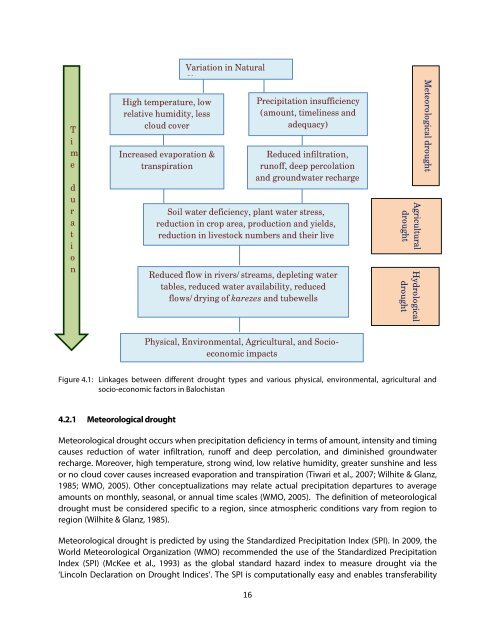Province of Balochistan Pakistan
Drought-Risk-Asst-Balochistan-Nov 2015-lowres
Drought-Risk-Asst-Balochistan-Nov 2015-lowres
You also want an ePaper? Increase the reach of your titles
YUMPU automatically turns print PDFs into web optimized ePapers that Google loves.
T<br />
i<br />
m<br />
e<br />
d<br />
u<br />
r<br />
a<br />
t<br />
i<br />
o<br />
n<br />
High temperature, low<br />
relative humidity, less<br />
cloud cover<br />
Increased evaporation &<br />
transpiration<br />
Variation in Natural<br />
Cli<br />
Precipitation insufficiency<br />
(amount, timeliness and<br />
adequacy)<br />
Reduced infiltration,<br />
run<strong>of</strong>f, deep percolation<br />
and groundwater recharge<br />
Soil water deficiency, plant water stress,<br />
reduction in crop area, production and yields,<br />
reduction in livestock numbers and their live<br />
Reduced flow in rivers/streams, depleting water<br />
tables, reduced water availability, reduced<br />
flows/drying <strong>of</strong> karezes and tubewells<br />
Agricultural<br />
drought<br />
Hydrological<br />
drought<br />
Meteorological drought<br />
Physical, Environmental, Agricultural, and Socioeconomic<br />
impacts<br />
Figure 4.1: Linkages between different drought types and various physical, environmental, agricultural and<br />
socio-economic factors in <strong>Balochistan</strong><br />
4.2.1 Meteorological drought<br />
Meteorological drought occurs when precipitation deficiency in terms <strong>of</strong> amount, intensity and timing<br />
causes reduction <strong>of</strong> water infiltration, run<strong>of</strong>f and deep percolation, and diminished groundwater<br />
recharge. Moreover, high temperature, strong wind, low relative humidity, greater sunshine and less<br />
or no cloud cover causes increased evaporation and transpiration (Tiwari et al., 2007; Wilhite & Glanz,<br />
1985; WMO, 2005). Other conceptualizations may relate actual precipitation departures to average<br />
amounts on monthly, seasonal, or annual time scales (WMO, 2005). The definition <strong>of</strong> meteorological<br />
drought must be considered specific to a region, since atmospheric conditions vary from region to<br />
region (Wilhite & Glanz, 1985).<br />
Meteorological drought is predicted by using the Standardized Precipitation Index (SPI). In 2009, the<br />
World Meteorological Organization (WMO) recommended the use <strong>of</strong> the Standardized Precipitation<br />
Index (SPI) (McKee et al., 1993) as the global standard hazard index to measure drought via the<br />
‘Lincoln Declaration on Drought Indices’. The SPI is computationally easy and enables transferability<br />
16


